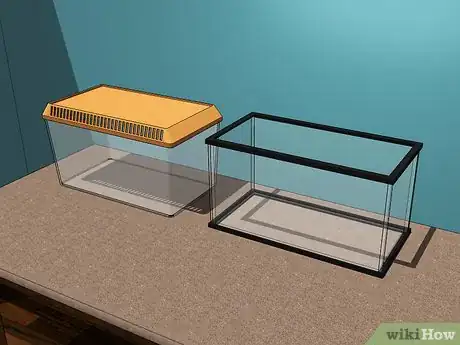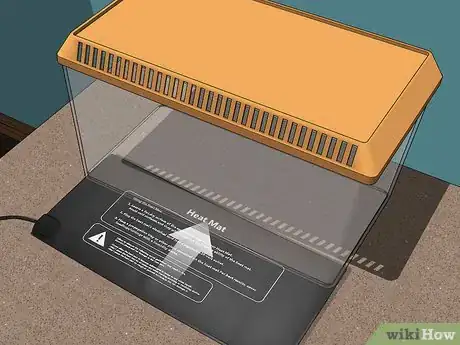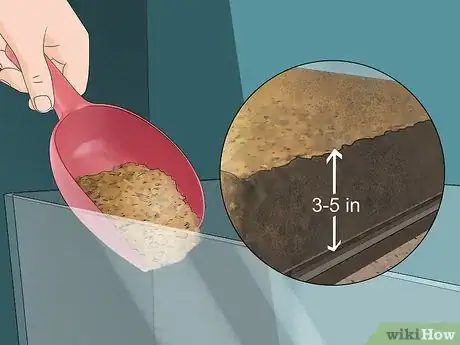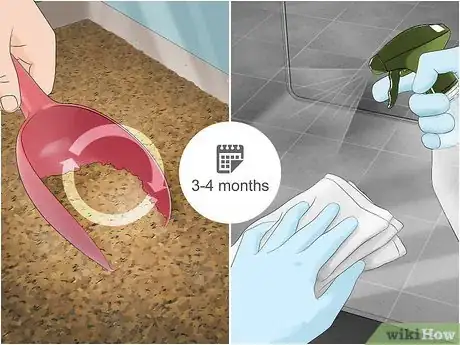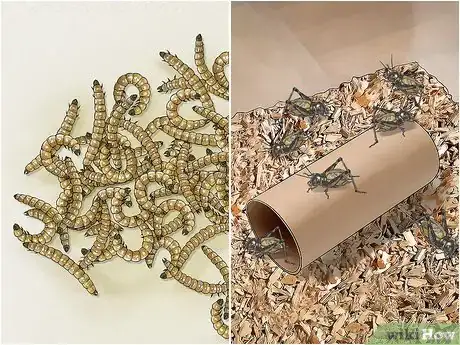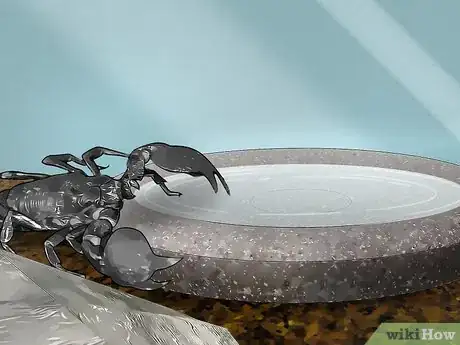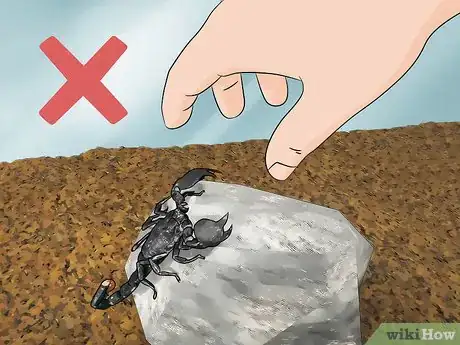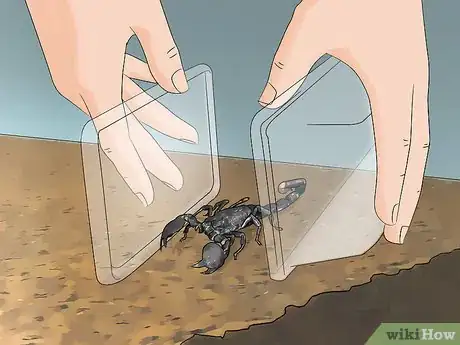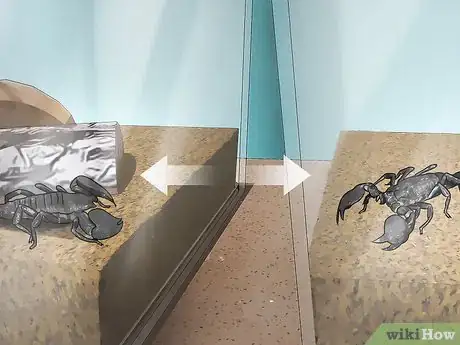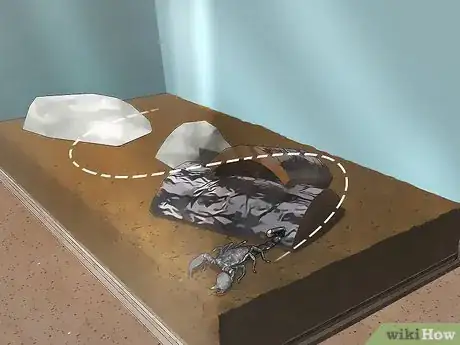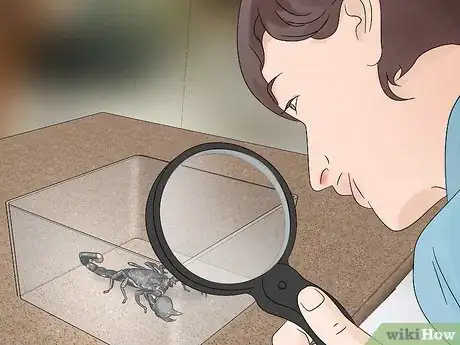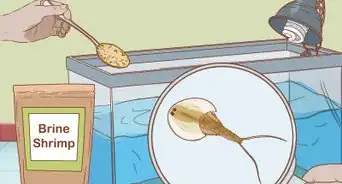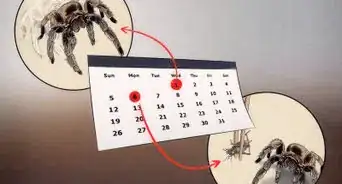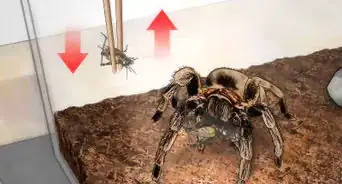This article was co-authored by Samuel Ramsey, PhD. Dr. Samuel Ramsey is an Entomologist and a researcher with the United States Department of Agriculture. Dr. Ramsey has extensive knowledge of symbiosis and specializes in insect disease spread, parasite behavior, mutualism development, biological control, invasive species ecology, pollinator health, and insect pest control. He holds a Bachelor’s degree in Entomology from Cornell University and a Ph.D. in Entomology from the University of Maryland. Dr. Ramsey’s research on bees has enabled researchers to develop targeted control techniques to restore honey bee populations worldwide. He also hosts a YouTube series called “Dr. Buggs.”
This article has been viewed 276,051 times.
The Emperor scorpion (Pandinus imperator)are a popular species of scorpion to keep as a pet, as they are impressively large and relatively docile. The species is native to tropical regions of Africa, although they can be kept as a pet anywhere in the world. Adult emperor scorpions average about 8 inches (20 cm) in length, making the species one of the largest in the world. These scorpions are known for having calm temperaments, which makes them tolerant of caregiver’s mistakes.[1] Emperor scorpions are fascinating animals, and can make for a great pet for a beginner branching out into arachnid pets.
Steps
Housing Your Emperor Scorpion
-
1House your scorpion in a terrarium or a fish tank. The tank can be made of either glass or plastic, but needs to be sturdy and well-ventilated, and should have a secure lid that latches shut. Emperor scorpions are strong and can lift a lid if it’s not secured. The tank should not be smaller than 10 gallons. If you plan to ever have two or three Emperor scorpions in the same tank, opt for a tank that’s 15 or 20 gallons.[2]
- You should be able to purchase a tank at any local pet store. You can also order glass or plastic terrariums online at pet-specific retail sites, or large retailers such as Amazon.
-
2Install a heat mat beneath the scorpion’s tank. Scorpions do not generate their own heat, and so need to be kept warm by their environment. You can provide heat for your scorpion by installing a heat mat under the tank.[3] This mat will regulate the enclosure’s temperature and keep the scorpion from becoming too cold.
- Emperor scorpions need a day time temperature of around 29ºC/85ºF and a night time low of 23ºC/75ºF. If you live in a cold environment, you may choose to hang a thermometer in the tank to measure the temperature.
Advertisement -
3Cover the floor with 3-5 inches of substrate. Substrate gives the scorpion a loose ground layer to burrow in, and preserves relatively high humidity in the tank. Cover the floor with a thick layer of substrate, common materials for which include sterilized potting soil, cocoa fiber, peat, peat/vermiculite, or cork bark.[4]
- The substrate should be kept moist by daily spraying with a water bottle. Spray the substrate until it is slightly damp, not wet or saturated.
- Moss can also be added to the substrate, as it will retain moisture and humidity. Don’t cover all of the substrate with moss, however, as it will impede the scorpion from digging down into the substrate.
-
4Provide obstacles in the terrarium. Scorpions like to engage and interact with their environment, so provide objects like bark and rocks for your scorpion to climb, burrow, and hide beneath. Suitable shelters include cork bark, a partial log, driftwood, or a flower pot. Having these objects in the cage will also make the scorpion a more enjoyable pet for you, as you can watch it interact with its environment.[5]
- Emperor scorpions love to climb, so you can place some short branches in the terrarium to stimulate interest.
-
5Do not place bright or warm lights around the cage. Since scorpions are nocturnal animals, they don’t like bright lights. Keep the tank out of direct sunlight and away from radiators and other sources of heat. This species is especially vulnerable to UV light, and too much exposure will stress the scorpion, which in severe cases will lead to its death.
- If you’d like the cage to be well lit so that you can see your pet scorpion, place the enclosure near a window or near a fluorescent light.
-
6Clean your scorpion’s enclosure regularly. Scorpions don’t make much mess, but any food remains should be removed daily. Change the substrate and clean and disinfect the tank every 3 or 4 months using an arachnid-friendly disinfectant.
- Once your scorpion molts, you’ll also need to remove the shed skin.
Feeding Your Scorpion
-
1Prepare an insect-based diet for your scorpion. Just as they would in the wild, captive Emperor scorpions need to eat live insects.[6] Feed your scorpion live crickets, locusts, and mealworms. The insects themselves should be fed beforehand with a nutrient rich mixture available from pet shops (this is known as “gut-loading”).[7]
- You can purchase gut-loaded crickets and mealworms at any local pet shop that sells arachnids and reptiles. Gut-loaded insects are also available online at any major pet retail site.
- If you’re caring for a baby or juvenile Emperor scorpion, feed it small insects, including pinhead crickets.
-
2Feed your scorpion at least twice a week. Scorpions do not need to eat every day, but should be fed somewhat frequently. If you scorpion is very hungry during its weekly feeding, you can start feeding it every few days. On the other hand, if you’re feeding it every three days and it often eats only a single cricket, you can feed it less frequently[8]
- Adult scorpions molt once or twice a year and don’t eat before and after molting. Don’t be alarmed if you notice this behavior.
-
3Feed your scorpion two to three insects per feeding. Don’t overwhelm your scorpion by throwing a handful of live crickets or mealworms into its enclosure. Instead, place 2 or 3 insects on the substrate near the scorpion, and let it eat them at its leisure. Scorpions can be temperamental eaters, and sometimes may refuse food altogether.[9]
- It’s okay if you leave uneaten crickets in the cage with the scorpion. Keeping live crickets in the tank will never hurt your scorpions.
-
4Provide your scorpion with water. Scorpions drink a lot of water, so make sure it is available every day. It’s best to provide water in a shallow, sturdy dish that the scorpion can’t knock over. The Emperor scorpion may want to crawl in the water dish to help it cool down. Give your scorpion fresh water daily, and wash the water dish every week or two.[10]
- Do not soak cotton wool in bottled water and place it in a small dish for your scorpion to drink from. This can be very harmful for your scorpion, and may even result in its death.
Handling and Caring For Your Scorpion
-
1Avoid handling your scorpion. Although Emperor scorpions are generally docile, they can still sting or pinch. The pinch will hurt, since Emperor scorpions have large and powerful claws. Emperor scorpion’s stings can feel similar to a bee’s or a hornet’s sting: its poison is mild, but the sting will hurt.
- It’s very unlikely that you’ll be allergic to the scorpion’s venom, although venom allergies do exist. If you notice swelling or experience substantial pain after a sting, consult your doctor.
-
2Move your scorpion by coaxing it into a plastic container. If you need to move the scorpion for any reason, avoid using your hands to pick up and move the pet. Instead, coax it into a ventilated box—such as a clean plastic margarine container—that can be closed easily once the scorpion enters it. Ensure that the container has holes poked in the lid and sides for air ventilation.[11]
- Alternately, you can pick the scorpion up using a pair of tongs or forceps. Do this gently, so that you don’t accidentally crush its shell.[12]
-
3Keep multiple Emperor scorpions in separate tanks. Emperor scorpions are not social animals; they prefer to live alone rather than living in groups. Scorpions may eat one another if housed together. It’s also not uncommon for multiple scorpions to fight over the same piece of food or insect if they’re housed in the same enclosure. (However, keeping an adequate amount of food in their tank should prevent that from happening.[13] )
- Emperor scorpions can be housed together, but they enjoy their personal space and merely tolerate each other. If you feel that you need multiple scorpions, make sure there are plenty of hiding places, as the animals may become territorial.
-
4Allow your scorpion to move freely around its enclosure. Scorpions will get any exercise they need from within their enclosure. If your scorpion appears to not be exercising, or is moving around too much, contact your local vet or the animal store from where you obtained your scorpion.
- Don’t be alarmed if your scorpion hides or remains motionless for most of the day. Emperor scorpions are nocturnal and will emerge and move around at night.[14]
-
5Take your scorpion to the vet for any health concerns. Emperor scorpions are generally healthy pets, and should have few health concerns if kept in the right conditions. The most common health problems relate to the terrarium’s and scorpion’s temperature. If the scorpion is overheated, it will become very active, may appear to sting itself, and finally roll over on its back. [15]
- If the animal is too cold, it will burrow into the substrate lining the bottom of the enclosure. The animal also may not eat.
Expert Q&A
Did you know you can get expert answers for this article?
Unlock expert answers by supporting wikiHow
-
QuestionWhat are the best kinds of insects to feed my scorpion?
 Samuel Ramsey, PhDDr. Samuel Ramsey is an Entomologist and a researcher with the United States Department of Agriculture. Dr. Ramsey has extensive knowledge of symbiosis and specializes in insect disease spread, parasite behavior, mutualism development, biological control, invasive species ecology, pollinator health, and insect pest control. He holds a Bachelor’s degree in Entomology from Cornell University and a Ph.D. in Entomology from the University of Maryland. Dr. Ramsey’s research on bees has enabled researchers to develop targeted control techniques to restore honey bee populations worldwide. He also hosts a YouTube series called “Dr. Buggs.”
Samuel Ramsey, PhDDr. Samuel Ramsey is an Entomologist and a researcher with the United States Department of Agriculture. Dr. Ramsey has extensive knowledge of symbiosis and specializes in insect disease spread, parasite behavior, mutualism development, biological control, invasive species ecology, pollinator health, and insect pest control. He holds a Bachelor’s degree in Entomology from Cornell University and a Ph.D. in Entomology from the University of Maryland. Dr. Ramsey’s research on bees has enabled researchers to develop targeted control techniques to restore honey bee populations worldwide. He also hosts a YouTube series called “Dr. Buggs.”
Entomologist Emperor scorpions can really subdue any insect or arachnid smaller than themselves. It's actually a pretty good idea for you to grab some (non-poisonous) insects that might be hanging out outside, like grasshoppers or beetles, and feed them to the scorpion. They also like to eat big things like praying mantis.
Emperor scorpions can really subdue any insect or arachnid smaller than themselves. It's actually a pretty good idea for you to grab some (non-poisonous) insects that might be hanging out outside, like grasshoppers or beetles, and feed them to the scorpion. They also like to eat big things like praying mantis. -
QuestionDo I need to vary my scorpion's diet?
 Samuel Ramsey, PhDDr. Samuel Ramsey is an Entomologist and a researcher with the United States Department of Agriculture. Dr. Ramsey has extensive knowledge of symbiosis and specializes in insect disease spread, parasite behavior, mutualism development, biological control, invasive species ecology, pollinator health, and insect pest control. He holds a Bachelor’s degree in Entomology from Cornell University and a Ph.D. in Entomology from the University of Maryland. Dr. Ramsey’s research on bees has enabled researchers to develop targeted control techniques to restore honey bee populations worldwide. He also hosts a YouTube series called “Dr. Buggs.”
Samuel Ramsey, PhDDr. Samuel Ramsey is an Entomologist and a researcher with the United States Department of Agriculture. Dr. Ramsey has extensive knowledge of symbiosis and specializes in insect disease spread, parasite behavior, mutualism development, biological control, invasive species ecology, pollinator health, and insect pest control. He holds a Bachelor’s degree in Entomology from Cornell University and a Ph.D. in Entomology from the University of Maryland. Dr. Ramsey’s research on bees has enabled researchers to develop targeted control techniques to restore honey bee populations worldwide. He also hosts a YouTube series called “Dr. Buggs.”
Entomologist It is very important when you're caring for predatory arachnids like scorpions that you don't just feed them the same thing over and over. If you've been feeding your emperor scorpion just crickets its entire life, even if crickets are very, very nutritious food, they're only providing it with a limited stretch of nutrition there. It would be like you eating cucumbers for an entire year. There are a number of other elements of nutrition they need. Make sure that you give them other potential options to feed on.
It is very important when you're caring for predatory arachnids like scorpions that you don't just feed them the same thing over and over. If you've been feeding your emperor scorpion just crickets its entire life, even if crickets are very, very nutritious food, they're only providing it with a limited stretch of nutrition there. It would be like you eating cucumbers for an entire year. There are a number of other elements of nutrition they need. Make sure that you give them other potential options to feed on.
References
- ↑ http://www.scorpionpictureguide.com/scorpions/emperor-scorpion-care/
- ↑ http://www.scorpionpictureguide.com/pet-scorpion-tank-habitat/
- ↑ https://www.amentsoc.org/insects/caresheets/scorpions.html
- ↑ http://www.scorpionpictureguide.com/pet-scorpion-tank-habitat/
- ↑ http://www.scorpionpictureguide.com/pet-scorpion-tank-habitat/
- ↑ Samuel Ramsey, PhD. Entomologist. Expert Interview. 20 January 2021.
- ↑ http://www.scorpionpictureguide.com/scorpions/emperor-scorpion-care/
- ↑ http://www.scorpionpictureguide.com/pet-scorpion-food-diet/
- ↑ http://www.scorpionpictureguide.com/pet-scorpion-food-diet/
- ↑ http://www.scorpionpictureguide.com/pet-scorpion-food-diet/
- ↑ https://www.pbspettravel.co.uk/blog/emperor-scorpion-care/
- ↑ https://www.amentsoc.org/insects/caresheets/scorpions.html
- ↑ http://www.scorpionpictureguide.com/scorpions/emperor-scorpion-care/
- ↑ https://www.amentsoc.org/insects/caresheets/scorpions.html
- ↑ https://www.amentsoc.org/insects/caresheets/scorpions.html
About This Article
To care for emperor scorpions, start by setting them up in a 15-20 gallon terrarium or fish tank with a lid that latches shut to keep the scorpions from getting out. Make sure to install a heat mat under the tank, since scorpions can’t generate their own heat. Then, feed your scorpions 2-3 live insects, like crickets, locusts, or mealworms, at least twice a week, and provide them with fresh water every day. Try to refrain from handling your scorpions, or use tongs to pick them up if necessary, to avoid being pinched or stung. For more information, including how to choose the right substrate for your terrarium or tank, keep reading!
